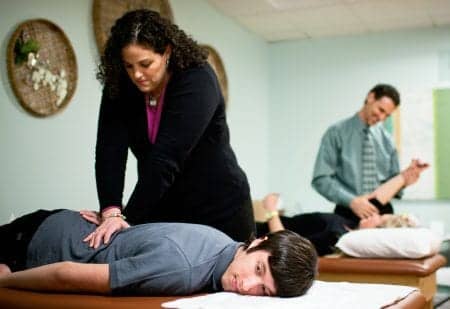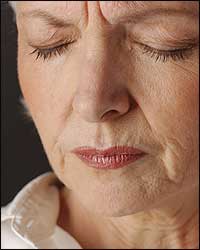
With its prevalence attributable to multiple risk factors, chronic low back pain has a recurrence rate as high as 84% and an average relapse rate of 58%.
It is said that greater than 80% of the adult population will experience back pain at some point in their lives. Among those who have low back pain, 25% to 40% will seek health care, accounting for 3% to 5% of all primary care consultations. Without intervention by health care, an everyday ache in the back can turn into a chronic condition.
Chronic low back pain (LBP) is prevalent among the general population due to multiple risk factors. These risk factors include a prior history of back pain and physical and mechanical strains such as repetitive bending (up to 3,000-5,000 times/day), poor sitting posture, whole body vibration as experienced in cars and other modes of transportation, and lack of lumbar extension. These basic mechanical strains can lead to ligament strain and disc displacement (most often posterior), otherwise known as mechanical derangement. Mechanical derangement can present as central LBP when there is a straight posterior bulge, or as a lateral protrusion with or without compression onto the affected level’s nerve root, causing what is known to the layman as sciatica. Left untreated, these symptoms can lead to motor or sensory loss, along with further loss of range of motion, causing pain when normal daily stresses are placed on these tightened tissues.
Basic anatomy of the spine entails an anterior vertebral body and a posterior spinous process. Between each vertebra is a disc that allows for shock absorption and movement of one bone over the other. The disc is comprised of a gelatinous center called the nucleus pulposus, and is enclosed by collagenous rings called the annulus fibrosus. Normal motion allows for movement of the nucleus in the opposite direction. For instance, when we bend over to touch our toes, the two anterior portions of the vertebral bodies close down anteriorly, pushing the nucleus posteriorly; bending backward will do the opposite with compression on the posterior aspect of the vertebral body and anterior displacement of the nucleus. When the nucleus is pushed so far posteriorly that it puts pressure on the outer third of the annulus, pain begins to generate, as this portion of the annulus is innervated by nerves. Pain is often felt centrally over the spinous process or diffusely across the entire low back. As the jelly-like center pushes further and further posteriorly, the limited space in the intervertebral canal forces a larger protrusion, or bulge, to shift laterally. This lateral deviation accounts for lateral pain referral and subjective complaints on one side. Progression of the bulge can deviate further laterally, involving the nerve root at that level. When pressure is placed on the nerve root the patient may feel symptoms of pain, pins and needles, or numbness in the dermatome of the involved nerve root as far distally as the foot and toes on the involved side.
Proper examination by a clinician can allow the patient to be placed into the correct classification, and treatment can begin. If the patient presents to the clinic with a mechanical derangement, the therapist will initiate treatment into the direction of preference that will centralize, move distal pain proximally, and abolish symptoms—versus the alternate direction, which can aggravate, worsen, peripheralize, or progress into limb from proximal to distal direction. In some cases, the patient can centralize and abolish with exercise alone. In other cases, the patient will require therapist intervention for force progression, overpressure to active exercise, joint mobilization, or sustained stretching, to centralize and abolish symptoms and to allow for greater success with their exercise routine. One approach to noninvasive treatment for managing chronic low back pain is to promote patient independence and self-treatment. If patients can be given the tools to actively treat themselves via the education and guidance of a physical therapist, they can begin to take control of their care and their lives.
For some patients, a structured exercise regimen aimed at restoring normal joint motion and core strength will provide the most benefit for chronic low back pain relief. Emphasis on lumbar stabilization to improve core control during daily activities in sitting and standing will allow for improved stability of the affected segments and less pain. Cardiovascular exercise is also important for improving circulation to affected tissue and to improve endurance for participation in premorbid activities.
IONTOPHORESIS FOR PAIN RELIEF REDUCES SYSTEMIC RISK
Back pain is a condition that can effectively be treated with iontophoresis, which provides a nonsystemic way to speed recovery, and can be used to treat a variety of patients. Some advantages iontophoresis offers include reduced risk of infection or skin damage, elimination of the discomfort some patients experience with injections, and reduced risk of systemic side effects. Frequently, iontophoresis is used to deliver anti-inflammatory medications to treat conditions such as plantar fasciitis, bursitis, and medial/lateral epicondylitis. The latest iontophoresis systems are integrated, and though they still must be set up in the clinic, they offer patients the freedom to return to their daily activities while receiving treatment.
Modalities for chronic back pain can serve many purposes. These include decreasing pain, inflammation, and spasms while improving circulation for tissue healing and preparing for stretching. Use of modalities for the treatment of chronic back pain should be an adjunct to manual and active rehabilitation, not just a passive treatment. There are many different types of modalities used; however, only a few will be discussed here. Modalities can be thermal, electrical, and used with or without medications.
Heat and cold therapy have been around for a very long time and are the most common modalities used. They are part of the RICE treatment used for acute injuries; however, they also have their place in treatment of chronic pain. Both heat and cold therapy are good for patients to use at home. You can use home-made hot packs such as rice placed in a tube sock and heated in a microwave for a few seconds, then wrapped in a towel before placing on the body. A frozen bag of peas or a mixture of alcohol and water in a zip lock bag can be used as a cold pack (remember to place in a towel before use). There are also commercial hot/cold packs available for home use.
Hot packs/moist hot packs and cold packs are used for muscle spasms and to decrease any residual inflammation in or surrounding tissues. Most people use heat prior to exercise or stretching and ice after treatment. If there is a significant amount of inflammation, one can alternate hot and cold.
Heat is used with pain because it dilates the blood vessels, bringing nutrients and oxygen to the affected area. Heat also promotes improved circulation so that as good elements come in, more toxic items are removed. This aids in tissue healing. Another reason to use heat is because it aids in preparing the soft tissue for stretching. Once stretching occurs, there is less stiffness, decreasing the pain sensation. Heat therapy contraindications include impaired sensation, thermal injury, circulatory problems, DVT, infections, malignant tumors, and hyper/hypo sensitivity to heat.
Cold therapy is used after treatment to constrict blood vessels, helping to decrease inflammation in the area of injury. It also numbs the sore tissue by slowing nerve impulses. Cold therapy should not be used with RA, Raynaud’s syndrome, cold allergic reaction, certain cardiac conditions, and impaired sensation.
Electrical stimulation (E-stim) can be very helpful when treating chronic pain. How e-stim works depends on the type of stimulation used. E-stim can aid in releasing endorphins and other natural pain control hormones to decrease pain sensation. Most commonly, e-stim is used on the basis of the gate control theory. This theory states that an analgesic effect occurs when the e-stim produces an inhibition of the C-fiber nociception by the impulses in the activated myelinated fibers (from the e-stim). This aids in decreasing further central transmission of impulses to the cortex.
The types of e-stim that will be discussed here include TENS and interferential current IFC. TENS is a high frequency electrical stimulation that is usually more toleraable and can be used for hours at one time. The overall pain relief, however, is for a shorter period once the TENS unit has been removed. TENS treatment is aimed at controlling pain via the gate control theory by stimulating the peripheral nerves around the injured area. The increased stimulation to the sensory nerves in the dorsal horn of the spinal cord decreases the transmission of pain sensation to the brain. There are no other physiological effects.
Interferential current is aimed at the deeper tissues and is set to the patient’s tolerance. It is a lower frequency and usually tolerated for only 20 minutes to 30 minutes, but the pain relief has a longer lasting effect. IFC encourages the release of endorphins at the cellular level by triggering the action potential, causing the release of neurotransmitters, including endorphins. IFC is also used as an anti-inflammatory modality.
In summary, patients should be confident they do not have to live with chronic LBP. There are physical therapists trained to look at the spine from a specific mechanical standpoint, and capable of changing the pain and functional deficits associated with back pain.
Tammy P. Mayo, MPT, ATC, Certified MDT, and Leslie Weissman, OTR/L, CHT, are on staff at Apple Rehab Sport & Spa, Avon, Conn. For more information, contact .





